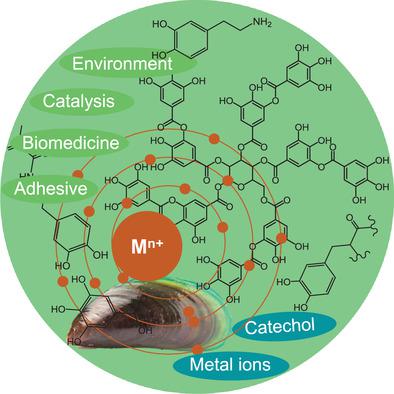当前位置:
X-MOL 学术
›
Adv. Mater. Interfaces
›
论文详情
Our official English website, www.x-mol.net, welcomes your
feedback! (Note: you will need to create a separate account there.)
The Cross-Linking Mechanism and Applications of Catechol–Metal Polymer Materials
Advanced Materials Interfaces ( IF 4.3 ) Pub Date : 2021-09-12 , DOI: 10.1002/admi.202100239 Guihua Yan 1 , Gaofeng Chen 1 , Zhiqing Peng 1 , Zhiliang Shen 1 , Xing Tang 1, 2 , Yong Sun 1, 2 , Xianhai Zeng 1, 2 , Lu Lin 1, 2
Advanced Materials Interfaces ( IF 4.3 ) Pub Date : 2021-09-12 , DOI: 10.1002/admi.202100239 Guihua Yan 1 , Gaofeng Chen 1 , Zhiqing Peng 1 , Zhiliang Shen 1 , Xing Tang 1, 2 , Yong Sun 1, 2 , Xianhai Zeng 1, 2 , Lu Lin 1, 2
Affiliation

|
Catechol plays an important role in many systems by interacting with organic (e.g., amino acids) and inorganic (e.g., metal ions, metal oxides) compounds. Catechol cross-linked polymer networks exhibit significant mechanical strength, good adhesiveness, and life-like characteristics. Recently, catechol–metal coordination materials have aroused increasing interest in multifunctional applications. Numerous influential studies have demonstrated that the type of metal ions and the structure of phenolic (such as natural phenolic (e.g., tannic acid, gallic acid, and lignin) or synthetic catechol-containing polymers) play important roles in the formation of catechol–metal coordination complexes. Although catechol–metal-based materials have been successfully prepared, the cross-linking chemistry between catechol and metal ions is still an important topic. To achieve catechol–metal-based materials with controllable and superior performance like living organisms, an in-depth understanding of the cross-linking mechanism is crucial. This review summarizes some studies on the coordination of catechol–metal-based materials, as well as the chemical mechanism behind the cross-linking of metal ions and catechol-containing molecules. The pathways and parameters that can affect the cross-linking are also discussed. Their advanced applications in the energy strategy, environmental filtration, biomedical, mechanical, adhesive, and some emerging fields, together with the current trends are also explored.
中文翻译:

儿茶酚-金属高分子材料的交联机理及应用
儿茶酚通过与有机(例如氨基酸)和无机(例如金属离子、金属氧化物)化合物相互作用而在许多系统中发挥重要作用。儿茶酚交联聚合物网络表现出显着的机械强度、良好的粘合性和栩栩如生的特性。最近,儿茶酚-金属配位材料在多功能应用中引起了越来越多的兴趣。大量有影响的研究表明,金属离子的类型和酚类(如天然酚类(如单宁酸、没食子酸和木质素)或合成的含儿茶酚聚合物)的结构在儿茶酚-金属的形成中起着重要作用。配合物。尽管已经成功制备了儿茶酚金属基材料,但儿茶酚与金属离子之间的交联化学仍然是一个重要的课题。为了实现像活生物体一样具有可控和优越性能的儿茶酚金属基材料,深入了解交联机制至关重要。本综述总结了一些关于儿茶酚-金属基材料的配位研究,以及金属离子和含儿茶酚分子交联背后的化学机制。还讨论了可能影响交联的途径和参数。还探讨了它们在能源战略、环境过滤、生物医学、机械、粘合剂和一些新兴领域的先进应用以及当前趋势。本综述总结了一些关于儿茶酚-金属基材料的配位研究,以及金属离子和含儿茶酚分子交联背后的化学机制。还讨论了可能影响交联的途径和参数。还探讨了它们在能源战略、环境过滤、生物医学、机械、粘合剂和一些新兴领域的先进应用以及当前趋势。本综述总结了一些关于儿茶酚-金属基材料的配位研究,以及金属离子和含儿茶酚分子交联背后的化学机制。还讨论了可能影响交联的途径和参数。还探讨了它们在能源战略、环境过滤、生物医学、机械、粘合剂和一些新兴领域的先进应用以及当前趋势。
更新日期:2021-10-08
中文翻译:

儿茶酚-金属高分子材料的交联机理及应用
儿茶酚通过与有机(例如氨基酸)和无机(例如金属离子、金属氧化物)化合物相互作用而在许多系统中发挥重要作用。儿茶酚交联聚合物网络表现出显着的机械强度、良好的粘合性和栩栩如生的特性。最近,儿茶酚-金属配位材料在多功能应用中引起了越来越多的兴趣。大量有影响的研究表明,金属离子的类型和酚类(如天然酚类(如单宁酸、没食子酸和木质素)或合成的含儿茶酚聚合物)的结构在儿茶酚-金属的形成中起着重要作用。配合物。尽管已经成功制备了儿茶酚金属基材料,但儿茶酚与金属离子之间的交联化学仍然是一个重要的课题。为了实现像活生物体一样具有可控和优越性能的儿茶酚金属基材料,深入了解交联机制至关重要。本综述总结了一些关于儿茶酚-金属基材料的配位研究,以及金属离子和含儿茶酚分子交联背后的化学机制。还讨论了可能影响交联的途径和参数。还探讨了它们在能源战略、环境过滤、生物医学、机械、粘合剂和一些新兴领域的先进应用以及当前趋势。本综述总结了一些关于儿茶酚-金属基材料的配位研究,以及金属离子和含儿茶酚分子交联背后的化学机制。还讨论了可能影响交联的途径和参数。还探讨了它们在能源战略、环境过滤、生物医学、机械、粘合剂和一些新兴领域的先进应用以及当前趋势。本综述总结了一些关于儿茶酚-金属基材料的配位研究,以及金属离子和含儿茶酚分子交联背后的化学机制。还讨论了可能影响交联的途径和参数。还探讨了它们在能源战略、环境过滤、生物医学、机械、粘合剂和一些新兴领域的先进应用以及当前趋势。










































 京公网安备 11010802027423号
京公网安备 11010802027423号